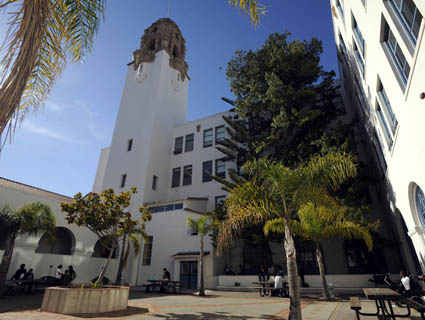
Photo: Mark Murrmann
A few years ago, many Latino students at Mission High school failed to correctly answer this standardized test question: “Do you chop, mince, slice, or grind the ingredients of salsa?” Well, depending on which culture you come from, you might do one or all of the above. “I’ve seen it made in the blender, minced, and sliced,” Principal Eric Guthertz told me this week. Another test question described teacups with saucers. “Culturally, most of our students don’t drink tea with saucers,” he says.
These are the kinds of reading-related questions high school students are about to ponder on the California Standardized Tests, which are coming up in a few weeks. To be fair: Guthertz notes that these are extreme examples, and that some kind of education accountability measures are needed. But “who is writing these tests and for whom?” Guthertz wonders aloud, as we sit in his office one recent rainy day and talk about how President Obama might revamp the No Child Left Behind Act. According to current measurements, four out of five schools could be labeled as failures, which implies that either the current scales are broken, or kids are. “The way this law is currently written just doesn’t measure the intelligence and achievement of our students,” Guthertz tells me.
Civil rights groups and community based organizations like the NAACP and the Advancement Project claim that failed measurement policies have actually pushed more students of color and low-income students into prisons than colleges. In a recent report (PDF), these groups argue that some schools are “increasing” their test scores by “punishing” failing students through suspensions, expulsions, and school-based arrests. Over 150 organizations have endorsed the report, urging federal policy makers to fix NCLB. President Obama announced last week that he wants to improve the quality of testing and give more control over the testing to local and state governments.
Given how much policymaker handwringing there is over low standardized test scores, it’s shocking to discover how little most high school students actually care about correctly answering questions on the standardized tests. Why? Because good test scores won’t help them get into college, they tell me. Test scores won’t help them get scholarships either. Students know that college admissions judges will look at their grades, essays, and community engagement. So why should they care about NCLB? Here’s how Principal Guthertz and teachers at Mission High are improvising to turn the school funding “sticks” of NCLB into student “carrots.”
When Guthertz first became a principal in 2008, he promised students that if they helped Mission High to raise test scores, he’d get a school mascot tattooed on his shoulder. Test scores went up in 2009, and have been going up since then, so Guthertz now proudly sports a Mission High Bears tattoo on his shoulder.
In the weeks leading up to the tests, teachers are helping students examine their individual scores and work in groups to support each other. There is free pizza involved in many of these discussions. The teachers also remind students, for example, that if they score low, they have to give up fun electives like the music choir and take intervention and support courses instead.
This year, Principal Guthertz told me he has lined up five famous chefs from top restaurants in San Francisco, like Frances and the Slanted Door, to serve gourmet meals to the 900 students. Fifteen volunteers from Charles Schwab will work as waiters the day of the celebration, and history teacher Amadis Velez has agreed to DJ at the party.
So, hopefully, students like Darrell will remember the meaning of the word “saucer,” and Vana will remember how those test writers think she should be mixing salsa. I’m following these and other Mission High students as they prepare to take the standardized tests on April 19, so I’ll let you know.
*Editors’ Note: This education dispatch is part of an ongoing series reported from Mission High School, where education writer Kristina Rizga is embedded for the year. Names of students are changed. Read more: Should this pink-slipped teacher prepare students for a concert at the Symphony Hall or go job-hunting? Plus: Sign up for our weekly newsletter to get all of the latest Mission High dispatches.













